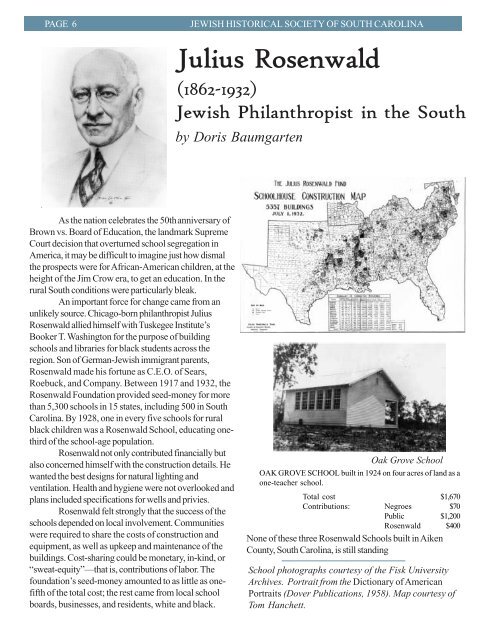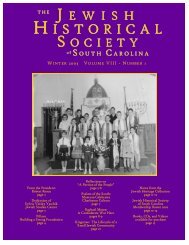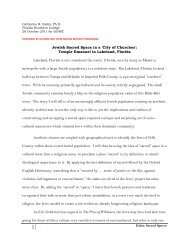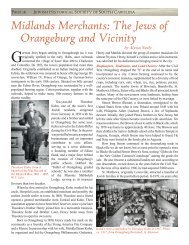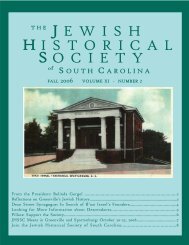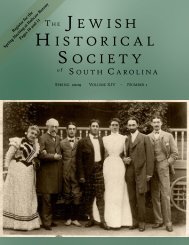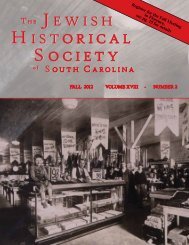PAGE 6JEWISH HISTORICAL SOCIETY OF SOUTH CAROLINAJulius Rosenwald(1862-1932)<strong>Jewish</strong> Philanthropist in the <strong>South</strong>by Doris BaumgartenAs the nation celebrates the 50th anniversary <strong>of</strong>Brown vs. Board <strong>of</strong> Education, the landmark SupremeCourt decision that overturned school segregation inAmerica, it may be difficult to imagine just how dismalthe prospects were for African-American children, at theheight <strong>of</strong> the Jim Crow era, to get an education. In therural <strong>South</strong> conditions were particularly bleak.An important force for change came from anunlikely source. Chicago-born philanthropist JuliusRosenwald allied himself with Tuskegee Institute’sBooker T. Washington for the purpose <strong>of</strong> buildingschools and libraries for black students across theregion. Son <strong>of</strong> German-<strong>Jewish</strong> immigrant parents,Rosenwald made his fortune as C.E.O. <strong>of</strong> Sears,Roebuck, and Company. Between 1917 and 1932, theRosenwald Foundation provided seed-money for morethan 5,300 schools in 15 states, including 500 in <strong>South</strong><strong>Carolina</strong>. By 1928, one in every five schools for ruralblack children was a Rosenwald School, educating onethird<strong>of</strong> the school-age population.Rosenwald not only contributed financially butalso concerned himself with the construction details. Hewanted the best designs for natural lighting andventilation. Health and hygiene were not overlooked andplans included specifications for wells and privies.Rosenwald felt strongly that the success <strong>of</strong> theschools depended on local involvement. Communitieswere required to share the costs <strong>of</strong> construction andequipment, as well as upkeep and maintenance <strong>of</strong> thebuildings. Cost-sharing could be monetary, in-kind, or“sweat-equity”—that is, contributions <strong>of</strong> labor. Thefoundation’s seed-money amounted to as little as onefifth<strong>of</strong> the total cost; the rest came from local schoolboards, businesses, and residents, white and black.Oak Grove SchoolOAK GROVE SCHOOL built in 1924 on four acres <strong>of</strong> land as aone-teacher school.Total cost $1,670Contributions: Negroes $70Public $1,200Rosenwald $400None <strong>of</strong> these three Rosenwald Schools built in AikenCounty, <strong>South</strong> <strong>Carolina</strong>, is still standingSchool photographs courtesy <strong>of</strong> the Fisk UniversityArchives. Portrait from the Dictionary <strong>of</strong> AmericanPortraits (Dover Publications, 1958). Map courtesy <strong>of</strong>Tom Hanchett.
SUMMER <strong>2004</strong> VOLUME IX - NUMBER 2PAGE 7Seivern SchoolSEIVERN SCHOOL built in 1923-24 on four acres as a twoteacherschool.Total cost $2,708Contributions: Negroes $1,142Public $66Rosenwald $800Raised in Springfield, Illinois, young Julius hadjoined the fledgling Chicago concern named Sears,Roebuck and Company in 1897. Capitalizing on the RuralFree Delivery system instituted the following year by theU.S. Post Office, he helped Sears become the world’slargest retailer with the publication <strong>of</strong> the “Wish Book”distributed to thousands <strong>of</strong> rural households. Through thisthick, enticing catalog, anyone could order householdgoods and farm supplies, from clothing to canningequipment, medical supplies to tractor parts, seeds,chickens, and even an entire build-it-yourself house.Rosenwald credited Chicago’s SinaiCongregation, which he attended as a youth, for instillingin him the <strong>Jewish</strong> values <strong>of</strong> Tzedakah and Tikkun Olam.He supported many <strong>Jewish</strong> and non-<strong>Jewish</strong> causes,including the Federation <strong>of</strong> <strong>Jewish</strong> Charities, HullHouse, and the Museum <strong>of</strong> Science and Industry inChicago, Hebrew Union College in Cincinnati, the<strong>Jewish</strong> Theological Seminary in New York City, andblack YMCAs and YWCAs in cities across the country.REFERENCESPeter Ascoli. Address given to <strong>South</strong> <strong>Carolina</strong> Preservation<strong>Society</strong>, Columbia, S.C., April 10, 2003.Fisk University Archives, Nashville, Tennessee.Mary S. H<strong>of</strong>fschwelle, Preserving Rosenwald Schools(Washington D.C.: National Trust for Historic Preservation,n.d.).Allen Riddick, Aiken County Schools (Aiken, S.C.: RocketPublishers, <strong>2004</strong>).Website: www.rosenwaldplans.orgAiken Graded SchoolAIKEN GRADED SCHOOL built under the 1924-25 budgetand outfitted for nine teachers.Total cost $33,500Contributions: Negroes $3,500Whites $1,500Public $27,000Rosenwald $1,500According to grandson and biographer Dr.Peter Ascoli, Rosenwald’s <strong>Jewish</strong> heritage gave him aparticular affinity with African Americans. “The horrorsthat are due to race prejudice,” Rosenwald wrote in1911, “come home to the Jew more forcefully than toothers <strong>of</strong> the white race, on account <strong>of</strong> the centuries <strong>of</strong>persecution which they have suffered and still suffer.”The philanthropist refused to allow his name tobe used on any <strong>of</strong> the schools he helped bring intobeing, preferring that their names reflect communitypride. Poignantly, most <strong>of</strong> the remaining schools,whether abandoned or converted to other uses, todayare referred to as “Rosenwald Schools” by people livingnearby.ADDITIONAL SOURCESJames Anderson, The Education <strong>of</strong> Blacks in the <strong>South</strong>,1860–1935 (Chapel Hill: University <strong>of</strong> North <strong>Carolina</strong> Press,1988).Edwin Embree and Julia Waxman, Investment in People: TheStory <strong>of</strong> the Julius Rosenwald Fund (New York: Harper andBrothers, 1949).Adam Fairclough, Teaching Equality: Black Schools in theAge <strong>of</strong> Jim Crow (Athens: University <strong>of</strong> Georgia, 2001).Thomas W. Hanchett, “The Rosenwald Schools and BlackEducation in North <strong>Carolina</strong>,” North <strong>Carolina</strong> <strong>Historical</strong>Review LXV: 4 (October 1988).Louis Harlan, Separate and Unequal: Public SchoolCampaigns and Racism in the <strong>South</strong> States, 1901–1915(Chapel Hill: University <strong>of</strong> North <strong>Carolina</strong> Press, 1958).Alicestyne Turley-Adams, Rosenwald Schools in Kentucky,1917–1932 (Frankfort: Kentucky Heritage Council and theKentucky African American Heritage Commission, 1997).


